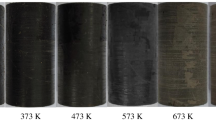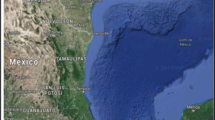Abstract
With the increase in global energy demand, people pay more and more attention to the development and utilization of unconventional oil and gas. Organic-rich shale is often considered as the source rock of unconventional oil and gas, and its physical properties will change greatly under the action of high temperature. Therefore, it is necessary to analyze and study the physical properties changes and reasons before and after high-temperature heat treatment. Taking the organic-rich shale of Niutitang Formation in Micangshan area of China as the research object, the physical parameters such as chromaticity, glossiness, hardness, capacitance, impedance, P-wave velocity, porosity, mass loss and TG/DSC were tested before and after heat treatment. The reasons for the changes of physical properties were analyzed in combination with the pyrolysis process of shale. The results are as follows: When the temperature is lower than 300 °C, the physical properties change slightly in a certain range, mainly dehydration reaction. In the temperature range of 300–450 °C, except for the decrease in wave velocity and capacitance, the other physical properties increase greatly. The main reaction is thermal decomposition of kerogen. When the temperature is between 450 °C and 600 °C, the hardness and porosity increase greatly, and the other physical properties continue to change slightly. The main reaction is the decomposition of asphalt and some inorganic minerals. By fitting the physical properties, it can be found that the wave velocity has a linear negative correlation with porosity and a linear positive correlation with capacitance. Porosity is positively correlated with mass loss rate and hardness growth rate. After 390 °C, the mass loss rate of shale increases greatly. The endothermic reaction mainly occurs before 530 °C. Due to the thermal decomposition of organic matter and inorganic mineral components in shale samples, the pore structure and mineral composition of the samples are greatly changed, which further leads to the change of physical properties.











Similar content being viewed by others
References
Bai F, Sun Y, Liu Y, Guo M. Evaluation of the porous structure of Huadian oil shale during pyrolysis using multiple approaches. Fuel. 2017;187:1–8.
Sun Y, Bai F, Liu B, Liu Y, Guo M, Guo W, Wang Q, Lü X, Yang F, Yang Y. Characterization of the oil shale products derived via topochemical reaction method. Fuel. 2014;115:338–346.
Chapiro G, Bruining J. Combustion enhance recovery of shale gas. J Peteol Sci Eng. 2015;127:179–189.
Holditch SA. Unconventional oil and gas resource development-let’s do it right. J Unconvent Oil Gas Resour. 2013;1:2–8.
Zou C, Dong D, Wang S, Li J, Cheng K. Geological characteristics and resource potential of shale gas in china. Petrol Explor Dev+. 2010;37(6):641–653.
Matson PA, Gadgil A. Annual review of environment and resources. Annu Rev Env Resour. 2013;38:V–VI.
Wang H, Liang J, Li X, Ji X, Zhang Q, Huang R. Analysis of the geological conditions for shale gas accumulation: two different carboniferous marine-continental transitional facies in the bayanhot basin, china. Energ Fuel. 2017;31(11):11515–11522.
Kok MV, Pamir MR. Non-isothermal pyrolysis and kinetics of oil shales. J Therm Anal Calorim. 1999;56(2):953–958.
Kok MV, Ilker S. Geological and thermal characterization of eskiehir region oil shales. J Therm Anal Calorim. 2014;116(1):367–372.
Kok MV, Guner G, Bagci S. Combustion kinetics of oil shales by reaction cell experiments. Oil Shale. 2008;25(1):5–16.
Na JG, Im CH, Chung SH, Lee KB. Effect of shale retorting temperature on shale oil yield and properties. Fuel. 2012;95:131–135.
Burnham AK. Chemistry and Kinetics of oil shale retorting. Oil shale. 2010;6:115–134.
Barkia H, Belkbir L, Jayaweera SAA. Kinetic studies of oxidation of residual carbon from moroccan oil shale kerogens. J Therm Anal Calorim. 2006;86(1):121–123.
Ge Z, Sun Q, Xue L, Yang T. The influence of microwave treatment on the mode I fracture toughness of granite. Eng Fract Mech. 2021;249:107768.
Yang T, Sun Q, Dong Z, Ge Z, Wang S, Xu C. A study on thermal damage mechanism of sandstone based on thermal reaction kinetics. Geomech Geophys Geo. 2021;7(3):1–13.
Wang Q, Jiao G, Liu H, Bai J, Li S. Variation of the pore structure during microwave pyrol ysis of oil shale. Oil shale. 2010;27(2):135–146.
Kok MV. Heating rate effect on the dsc kinetics of oil shales. J Therm Anal Calorim. 2007;90(3):817–821.
Schrodt JT, Ocampo A. Variations in the pore structure of oil shales during retorting and combustion. Fuel. 1984;63(11):1523–1527.
Kok MV, Pokol G, Keskin C, Madarász J, Bagci S. Combustion characteristics of lignite and oil shale samples by thermal analysis techniques. J Therm Anal Calorim. 2010;76(1):247–254
Duan Z, Cheng WC, Peng JB, Rahman MM, Tang H. Interactions of landslide deposit with terrace sediments: Perspectives from velocity of deposit movement and apparent friction angle. Eng Geol. 2021;280:105913.
Preusser F, Chithambo ML, Gtte T, Martini M, Ramseyer K, Sendezera EJ, Susino GJ, Wintle AG. Quartz as a natural luminescence dosimeter. Earth-Sci Rev. 2009;97(1–4):184–214.
Kaljuvee T, Keelmann M, Trikkel A, Kuusik R. Thermooxidative decomposition of oil shales. J Therm Anal Calorim. 2011;105(2):395–403.
Campbell JH, Gallegos G, Gregg M. Gas evolution during oil shale pyrolysis. 2. kinetic and stoichiometric analysis. Fuel. 1980;59(10):727–732.
Han XX, Jiang XM, Cui ZG. Studies of the effect of retorting factors on the yield of shale oil for a new comprehensive utilization technology of shale. Appl Energ. 2009;86(11):2381–2385.
Yan J, Jiang X, Han X, Liu J. A TG-FTIR investigation to the catalytic effect of mineral matrix in oil shale on the pyrolysis and combustion of kerogen. Fuel. 2013;104:307–317.
Aboulkas A, Harfi KE. Effects of acid treatments on moroccan tarfaya oil shale and pyrolysis of oil shale and their kerogen. J Therm Anal Calorim. 2009;37(6):659–667.
Allan AM, Clark AC, Vanorio T, Kanitpanyacharoen W, Wenk HR. On the evolution of the elastic properties of organic-rich shale upon pyrolysis-induced thermal maturation. Geophysics. 2016;81(3):D263–D281.
Eseme E, Urai JL, Krooss BM, Littke R. Review of mechanical properties of oil shales: implications for exploitation and basin modelling. Oil shale. 2010;24(2):159–174.
Li D, Li R, Tan C, Zhao D, Xue T, Zhao B, Khaled A, Liu F, Xu F. Origin of silica, paleoenvironment, and organic matter enrichment in the lower paleozoic niutitang and longmaxi formations of the northwestern upper yangtze plate: significance for hydrocarbon exploration. Mar Petrol Geol. 2019;103:404–421.
Sun H, Sun Q, Deng W, Zhang W, Lü C. Temperature effect on microstructure and p-wave propagation in Linyi sandstone. Appl Therm Eng. 2017;115:913–922.
Tiikma L, Zaidentsal A, Tensorer M. Formation of thermobitumen from oil shale by low-temperature pyrolysis in an autoclave. Oil shale. 2007;24(4):535–546.
Tiwari P, Deo M. Compositional and kinetic analysis of shale pyrolysis using TGA-MS. Fuel. 2012;94:333–341.
Torrente MC, Galán MA. Kinetics of the thermal decomposition of oil shale from Puertollano (Spain). Fuel. 2001;80(3):327–334.
Syed S, Qudaih R, Talab I, Janajreh I. Kinetics of pyrolysis and combustion of oil shale sample from thermogravimetric data. Fuel. 2011;90(4):1631–1637.
Acknowledgements
This research was supported by the National Natural Science Foundation of China (No. 41972288); Natural Science Basic Research Program of Shaanxi Province (No. 2020JQ-744); China Postdoctoral Science Foundation (No. 2020M673443) and fellowship of China Postdoctoral Science Foundation (No. 2020M683676XB).
Author information
Authors and Affiliations
Corresponding authors
Ethics declarations
Conflict of interest
On behalf of all authors, the corresponding author states that there is no conflict of interest.
Additional information
Publisher's Note
Springer Nature remains neutral with regard to jurisdictional claims in published maps and institutional affiliations.
Rights and permissions
About this article
Cite this article
Yang, T., Sun, Q., Li, D. et al. Study on the change of physical properties of Organic-rich shale after heat treatment. J Therm Anal Calorim 147, 6507–6517 (2022). https://doi.org/10.1007/s10973-021-10946-5
Received:
Accepted:
Published:
Issue Date:
DOI: https://doi.org/10.1007/s10973-021-10946-5




